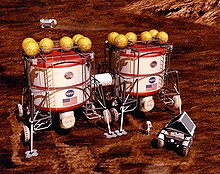Mars Design Reference Mission
[6] In 1997 a NASA Mars Exploration Study Team was put together and made a more detailed version of the original design reference mission.This report summarizes their work and describes a plan for the first human missions to Mars, using approaches that are technically feasible, have reasonable risks, and have relatively low costs.The architecture for the Mars Reference Mission builds on previous work of the Synthesis Group (1991) and Zubrin's (1991) concepts for the use of propellants derived from the Martian Atmosphere.The stated purpose of the Reference Mission was to stimulate further thought and development of alternative approaches: "It is intended to identify and clarify system "drivers", or significant sources of cost, performance, risk, and schedule variation.Comparing alternative approaches provides the basis for continual improvement to technology investment plans and general understanding of future human exploration missions.




approacheshuman mission to Marstrade studiesSpace Exploration InitiativeRobert ZubrinMars DirectNASA Design Reference Mission 3.0nuclear thermal propulsionelectric propulsionAustere Human Missions to MarsList of crewed Mars mission plansMars sample return missionWayback MachineHuman missionMars Base CampSpaceX Mars programMars Piloted Orbital StationMars to StayAurora programmeMars OneInspiration MarsVision for Space ExplorationThe Mars ProjectMartian Piloted ComplexAelitaRide ReportThe Case for MarsMars analogsMARS-500Mars Analogue Research Station ProgramArctic Mars Analog Svalbard ExpeditionConcordia StationHI-SEASCaves of Mars ProjectMars InstituteMars SocietyMars habitatCrewed Mars roverMars suitMars Excursion ModuleMars landerMars roverColonization of MarsExploration of MarsFictionMars cyclerMars orbit rendezvousTerraforming of MarsMars atmospheric entryMars flyby